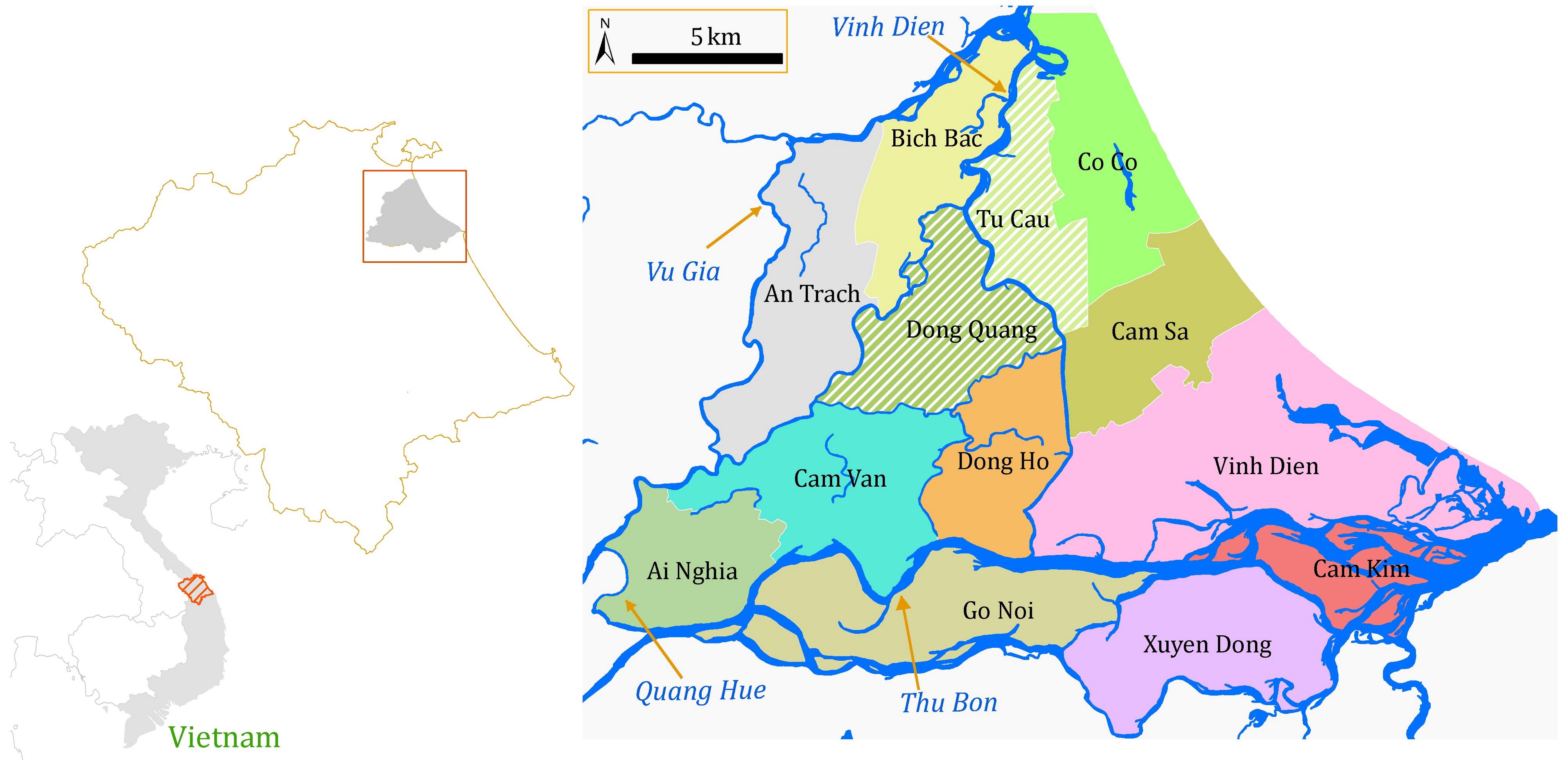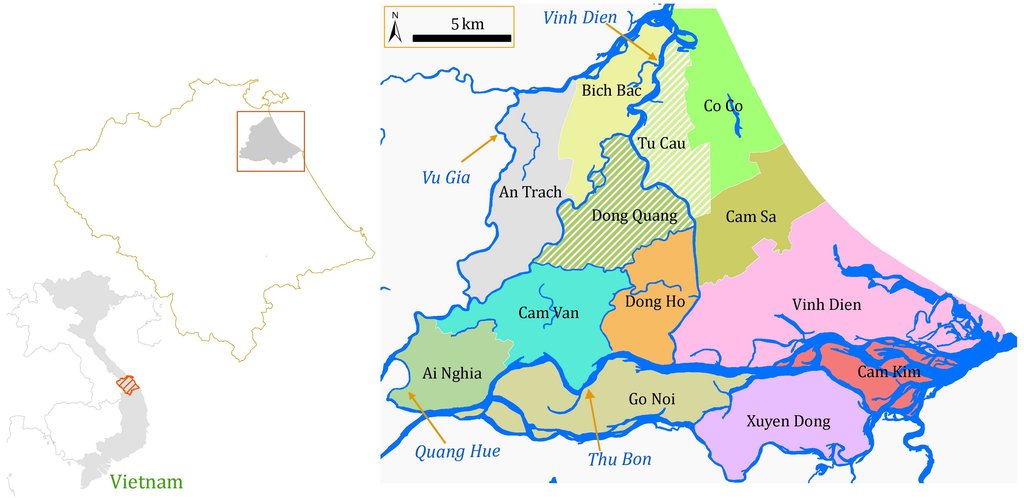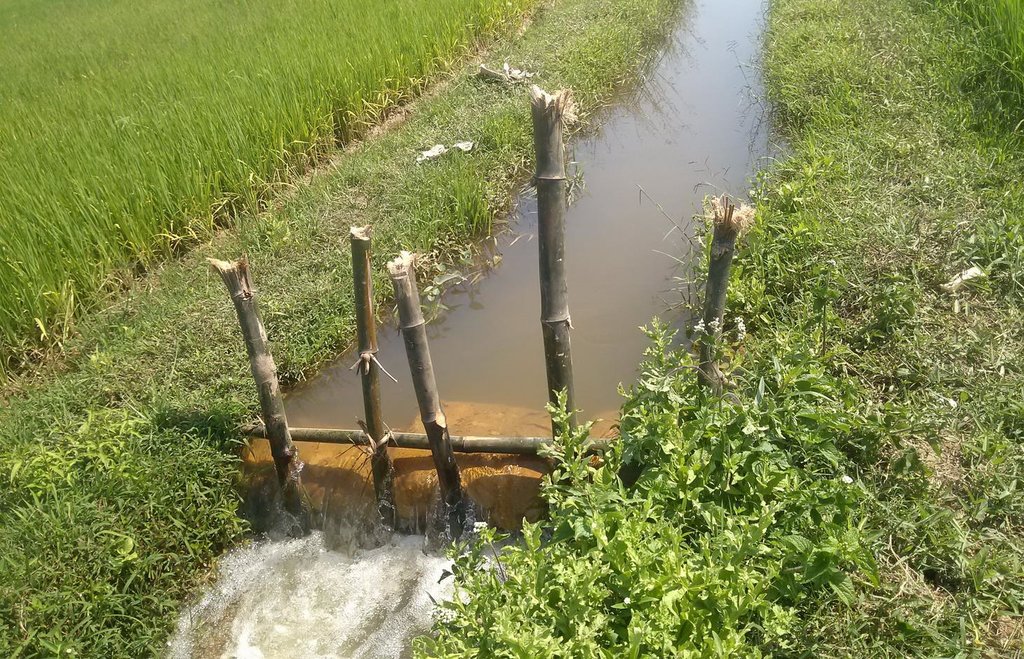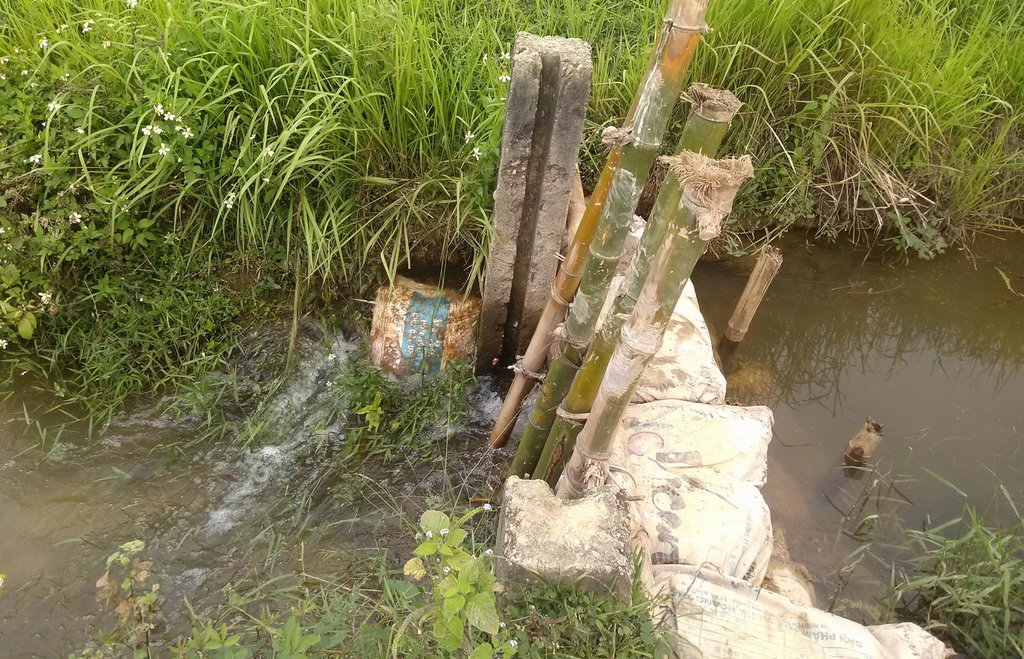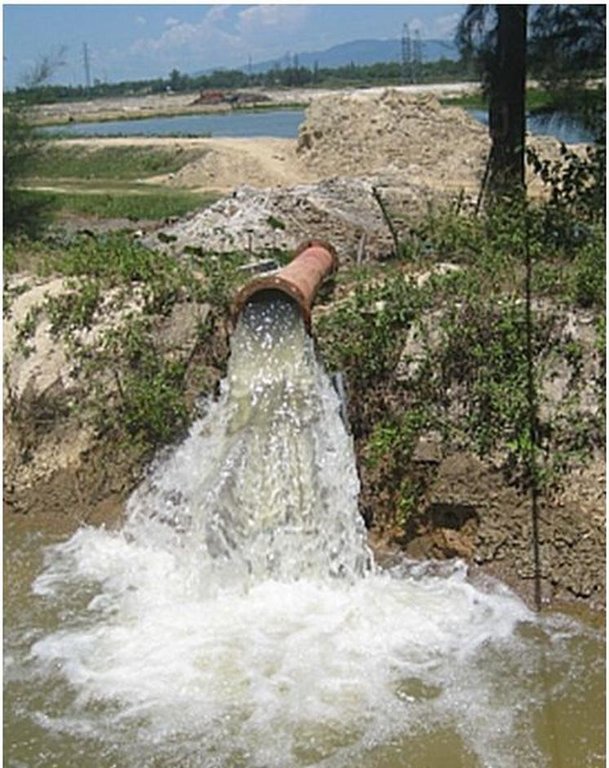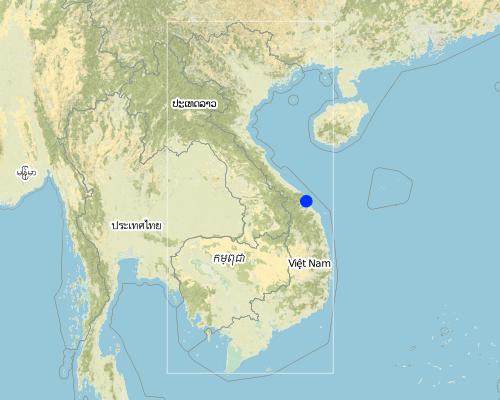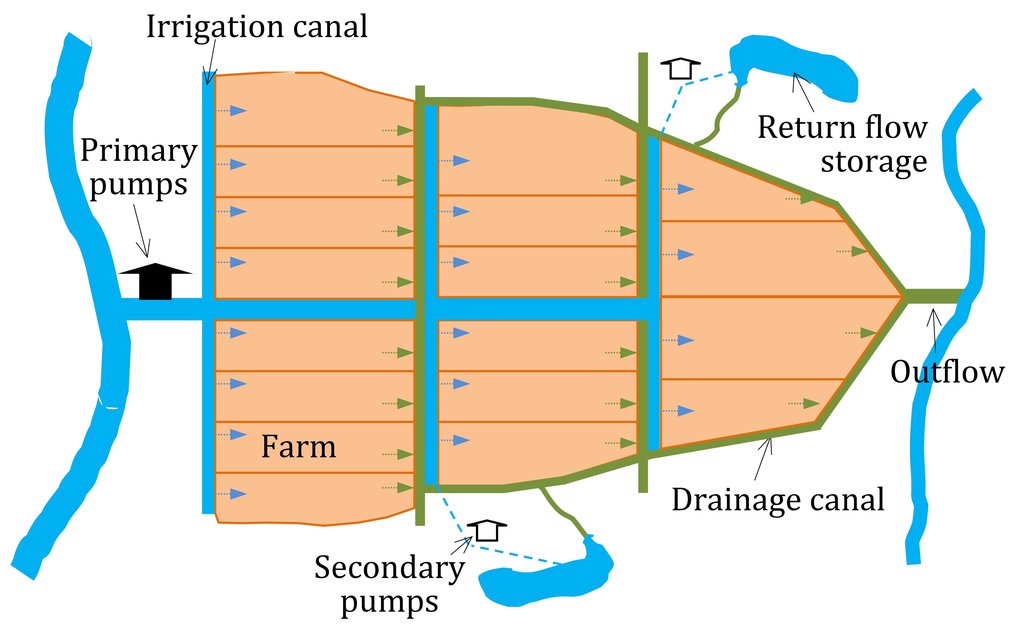Water saving through reuse of return flow in paddy fields [越南]
- 创建:
- 更新:
- 编制者: Justyna Sycz
- 编辑者: –
- 审查者: David Streiff, Deborah Niggli
technologies_1277 - 越南
- Water saving through reuse of return flow in paddy fields: Jan. 5, 2017 (inactive)
- Water saving through reuse of return flow in paddy fields: April 29, 2017 (inactive)
- Water saving through reuse of return flow in paddy fields: May 3, 2017 (inactive)
- Water saving through reuse of return flow in paddy fields: Aug. 11, 2019 (public)
查看章节
全部展开 全部收起1. 一般信息
1.2 参与该技术评估和文件编制的资源人员和机构的联系方式
有助于对技术进行记录/评估的项目名称(如相关)
Book project: Making sense of research for sustainable land management (GLUES)有助于对技术进行记录/评估的项目名称(如相关)
Land Use and Climate Change Interactions in Central Vietnam (LUCCi / GLUES)有助于对技术进行记录/评估的机构名称(如相关)
Technische Hochschule Köln (TH Köln) - 德国1.3 关于使用通过WOCAT记录的数据的条件
(现场)数据是什么时候汇编的?:
03/08/2015
编制者和关键资源人员接受有关使用通过WOCAT记录数据的条件。:
是
1.4 所述技术的可持续性声明
这里所描述的技术在土地退化方面是否存在问题,导致无法被认为是一种可持续的土地管理技术?:
否
1.5 请参阅有关SLM方法的问卷
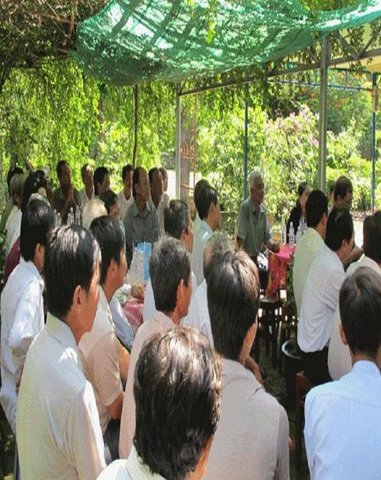
Vu Gia Thu Bon River Basin Information Centre [越南]
The VGTB River Basin Information Centre (RBIC) offers decision support tools for stakeholders and aims at providing comprehensive information and consulting services to the water and land users according to their demands.
- 编制者: Justyna Sycz
2. SLM技术的说明
2.1 技术简介
技术定义:
Return flow from paddy fields is strategically collected before being lost to rivers and is reused as an effective source of agricultural water.
2.2 技术的详细说明
说明:
Return flow from paddy fields is defined as applied water that is not lost by evapotranspiration but returns to an aquifer or surface water body (Womach, 2005). The two types of return flow are surface and sub-surface. Surface return flow accounts for the major proportion. If surface return flow is strategically collected before entering rivers, it can be used as an ‘extra’ effective source of agricultural water supply (Phil King, 2008; Simons et al., 2015). Because paddies effectively purify water by absorbing nitrogen and phosphorus, this produces return flow of an acceptable quality for irrigation purposes. Return flow can be collected by drainage canals and stored in ponds and reservoirs, and then returned to pumps for reapplication. This technology offers one solution towards overcoming a deficit of irrigation water.
The goal of this technology is to store and reuse surface return flow from paddy farms to enhance irrigation efficiency. The purpose of constructing temporary barriers in drainage canals is to minimise water wastage and optimise the possibility of collecting and recycling surface return flow. Return flow from irrigation system is stored in surrounding ponds and reservoirs Return flow can only be used when it is captured in a storage structure or drain which has a hydraulic link to the irrigation source: thus an integrated framework for the reuse system consisting of both hydraulic, and management, links should be established. Within the scope of this study, the Water Management Unit (WMU) is understood as an integrated irrigation and drainage system consisting of four components: (i) the hydrological catchment which covers both non-irrigated and irrigated area; (ii) the source scheme generating return flow; (iii) the reuse scheme that is hydraulically connected with the source scheme; and (iv) a drainage system functioning as a harvesting as well as a supply structure.
Before implementing such a system it is recommended to analyse the correlation between irrigation efficiency and reuse of return flow, as well as developing a framework for managing and recycling return flow. Investigation aims at identifying the potential of return flow for irrigation; determining its quantity and quality; and developing an efficient and sustainable reuse framework. Water balance calculations, field measurements, water quality sampling and interviewing are all used for this purpose.
In the study area, long dry seasons cause severe water shortages and problems with saline intrusion. The study area is mainly covered by paddy, vegetables and other annual crops such as maize, sweet potatoes, peanuts and sugarcane. Paddy rice, which consumes a high proportion of the freshwater, is the dominant crop. Agricultural land in the downstream area is irrigated through gravity or pump irrigation systems. Here results indicate that the irrigation efficiency can be improved significantly: the irrigation efficiency of Tu Cau and Thanh Quyt irrigation schemes is projected to increase respectively by 1.8 and 1.4 times.
Reuse of return flow can be applied in all WMUs where the drainage canals are connected with storage tanks. Scientific and technical support tools are offered by the Vu Gia Thu Bon River Basin Information Centre. The centre was established in Danang providing a comprehensive information service to farmers and other water users – it includes capacity building and consulting services also.
2.3 技术照片
2.5 已应用该技术的、本评估所涵盖的国家/地区/地点
国家:
越南
区域/州/省:
Quang Nam
有关地点的进一步说明:
Dien Ban
Map
×2.6 实施日期
如果不知道确切的年份,请说明大概的日期:
- 不到10年前(最近)
2.7 技术介绍
详细说明该技术是如何引入的:
- 通过土地使用者的创新
- 在实验/研究期间
3. SLM技术的分类
3.1 该技术的主要目的
- 改良生产
- 保护生态系统
3.2 应用该技术的当前土地利用类型

农田
- 一年一作
注释:
Major land use problems (compiler’s opinion): The lowland part of Vu Gia Thu Bon is an intensive agricultural area. Rice cultivation, which consumes a high proportion of fresh water, accounts for 70% of total agricultural land (Ribbe et al., 2011). Since 2005, due to the impacts of droughts and saltwater intrusion, water for irrigation during the dry seasons has become an increasing problem in the lowland area of this basin. Simultaneously, the irrigation efficiency of this region is relative low. Various measures are applied to address water scarcity for irrigation. Reusing return flow is regarded as a potentially new measure to reduce the severity of the irrigation deficit in dry periods.
Major land use problems (land users’ perception): Based on the information provided by the Department of Natural Resources and Environment (DONRE) for Quang Nam Province, this basin now faces the problem of temporarily insufficient irrigation water. This situation is caused by droughts, insufficient reservoir capacity, salinity intrusion and ineffective irrigation management.
3.3 有关土地利用的更多信息
该技术所应用土地的供水:
- 充分灌溉
每年的生长季节数:
- 2
具体说明:
Longest growing period in days: 130, Longest growing period from month to month: 20th December to 28th April; Second longest growing period in days: 110, Second longest growing period from month to month: 20th May to 06th September
3.4 该技术所属的SLM组
- 集水
- 地表水管理(泉、河、湖、海)
3.5 技术传播
注释:
Total area covered by the SLM Technology is 0.916 m2.
The research area is located in the downstream of the Vu Gia Thu Bon Basin (VGTB), Central Coast of Vietnam. Based on the hydraulic connectivity, the lowland of the VGTB is divided into 13 Water Management Units (WMU) (Viet, 2014). Of which, the Dong Quang and Tu Cau WMUs are selected to conduct the field survey and water quality sampling.
3.6 包含该技术的可持续土地管理措施

结构措施
- S5:大坝、集水斗、水池
- S6:墙、障碍物、栅栏、围墙

管理措施
- M2:改变管理/强度级别
- M6:废物管理(回收、再利用或减少)
3.7 该技术强调的主要土地退化类型

水质恶化
- Hs:地表水良变化
注释:
Main causes of degradation: crop management (annual, perennial, tree/shrub) (Paddy rice requires huge amounts of water. Meanwhile, the coefficient of irrigation return flow from paddy field is also quite high.), industrial activities and mining (Hydropower construction reduces water availability for irrigation), over abstraction / excessive withdrawal of water (for irrigation, industry, etc.) (It causes water waste and reduces irrigation efficiency.), change of seasonal rainfall (It affects the paddy water balance and actual irrigation need.), droughts (It causes saltwater intrusion.)
Secondary causes of degradation: change in temperature (It relates to evapotranspiration.), inputs and infrastructure: (roads, markets, distribution of water points, other, …), governance / institutional
3.8 防止、减少或恢复土地退化
具体数量名该技术与土地退化有关的目标:
- 减少土地退化
4. 技术规范、实施活动、投入和成本
4.1 该技术的技术图纸
4.2 技术规范/技术图纸说明
Methods of recycling return flow from paddy fields: The surface return flow can be captured by drainage canals and stored in tanks: return water from these reservoirs is pumped back into irrigation canals.
In 2012, the first on-farm irrigation structure was initially implemented in the Tu Cau WMU in order to use return flow for irrigation purposes. The existing Sen Pond was enlarged and a temporary pumping station was installed to pump water into the irrigation canal system.
According to the pumping diary of Tu Cau station (in Winter-Spring crop 2013), there were totally 7 irrigation periods (8-11 days/period). Total input water (including effective rainfall) during the measuring period from 01 March to 10 April was about 28,000 m3. Meanwhile the total volume of return flow of the Tu Cau site was 16,176 m3. This amount of return flow has the potential to irrigate the agricultural area for about 16 days, equivalent to one and a half irrigation periods. The overall efficiency of the irrigation system will be significantly improved.
Location: Lowland area of VGTB Basin. Quang Nam Province
Date: January 2014
Technical knowledge required for field staff / advisors: high
Technical knowledge required for land users: low
Main technical functions: water harvesting / increase water supply
Dam/ pan/ pond
Depth of ditches/pits/dams (m): 2
Width of ditches/pits/dams (m): 194.9
Length of ditches/pits/dams (m): 399.4
Wall/ barrier
Height of bunds/banks/others (m): 0.5
Width of bunds/banks/others (m): 0.25
Length of bunds/banks/others (m): 1.26
Construction material (other): Stone, sandy bags and bamboo sticks
Specification of dams/ pans/ ponds: Capacity 116764.59m3
Catchment area: 77860 m²m2
Beneficial area: 30 ham2
Other type of management: Return flow is the part of drainage flow, it is necessary to enhance the institutional link to develop the reuse framework for the study area. Think about reforming IMC to IDMC with D is drainage.
4.3 有关投入和成本计算的一般信息
其它/国家货币(具体说明):
VND
注明美元与当地货币的汇率(如相关):1美元=:
20828.0
4.4 技术建立活动
| 活动 | 措施类型 | 时间 | |
|---|---|---|---|
| 1. | Building temporary barrier in drainage canal | 结构性的 | |
| 2. | Dredging and expanding Sen Pond | 结构性的 | 12 months |
| 3. | Installing and operating the temporary pump at Sen Pond, P is 15KW (Q=520-600m3/h) | 结构性的 |
4.5 技术建立所需要的费用和投入
| 对投入进行具体说明 | 单位 | 数量 | 单位成本 | 每项投入的总成本 | 土地使用者承担的成本% | |
|---|---|---|---|---|---|---|
| 劳动力 | labour | 1.0 | 3046.52 | 3046.52 | ||
| 设备 | machine use | 1.0 | 5344.09 | 5344.09 | ||
| 设备 | hammer, iron wire | 1.0 | 2.4 | 2.4 | 100.0 | |
| 施工材料 | Stone,sandy bags,bamboo sticks | 1.0 | 6.45 | 6.45 | 100.0 | |
| 施工材料 | Earth, concrete | 1.0 | 1335.8 | 1335.8 | ||
| 技术建立所需总成本 | 9735.26 | |||||
注释:
Duration of establishment phase: 12 month(s)
4.6 维护/经常性活动
| 活动 | 措施类型 | 时间/频率 | |
|---|---|---|---|
| 1. | Temporary barrier | 结构性的 | each cropping season |
| 2. | Temporary pump | 结构性的 | annually |
4.7 维护/经常性活动所需要的费用和投入(每年)
| 对投入进行具体说明 | 单位 | 数量 | 单位成本 | 每项投入的总成本 | 土地使用者承担的成本% | |
|---|---|---|---|---|---|---|
| 劳动力 | labour | 1.0 | 24.0 | 24.0 | 30.0 | |
| 设备 | machine use | 1.0 | 38.41 | 38.41 | ||
| 施工材料 | Stone,sandy bags,bamboo sticks | 1.0 | 3.22 | 3.22 | 100.0 | |
| 技术维护所需总成本 | 65.63 | |||||
4.8 影响成本的最重要因素
描述影响成本的最决定性因素:
Prices of the material and equipment; the approval procedure and disbursement process of the project of “Dredging and expanding Sen Pond”; the compensation cost for the farmers; the cost of operating and maintaining temporary pump; the cost of reinforcing the drainage canals.
5. 自然和人文环境
5.1 气候
年降雨量
- < 250毫米
- 251-500毫米
- 501-750毫米
- 751-1,000毫米
- 1,001-1,500毫米
- 1,501-2,000毫米
- 2,001-3,000毫米
- 3,001-4,000毫米
- > 4,000毫米
有关降雨的规范/注释:
Average annual rainfall in period 1978-2010 of research area is 2105mm. February to April is driest period as rainfall in this period accounts only 3-5% of annual rainfall.
农业气候带
- 半湿润
Thermal climate class: tropics. humid tropical monsoon climate
5.2 地形
平均坡度:
- 水平(0-2%)
- 缓降(3-5%)
- 平缓(6-10%)
- 滚坡(11-15%)
- 崎岖(16-30%)
- 陡峭(31-60%)
- 非常陡峭(>60%)
地形:
- 高原/平原
- 山脊
- 山坡
- 山地斜坡
- 麓坡
- 谷底
垂直分布带:
- 0-100 m a.s.l.
- 101-500 m a.s.l.
- 501-1,000 m a.s.l.
- 1,001-1,500 m a.s.l.
- 1,501-2,000 m a.s.l.
- 2,001-2,500 m a.s.l.
- 2,501-3,000 m a.s.l.
- 3,001-4,000 m a.s.l.
- > 4,000 m a.s.l.
5.3 土壤
平均土层深度:
- 非常浅(0-20厘米)
- 浅(21-50厘米)
- 中等深度(51-80厘米)
- 深(81-120厘米)
- 非常深(> 120厘米)
土壤质地(表土):
- 粗粒/轻(砂质)
- 中粒(壤土、粉土)
表土有机质:
- 中(1-3%)
5.4 水资源可用性和质量
地下水位表:
< 5米
地表水的可用性:
中等
水质(未处理):
仅供农业使用(灌溉)
5.5 生物多样性
物种多样性:
- 低
5.6 应用该技术的土地使用者的特征
生产系统的市场定位:
- 生计(自给)
- 混合(生计/商业
非农收入:
- > 收入的50%
相对财富水平:
- 贫瘠
- 平均水平
个人或集体:
- 个人/家庭
机械化水平:
- 手工作业
- 机械化/电动
性别:
- 女人
- 男人
说明土地使用者的其他有关特征:
Land users applying the Technology are mainly common / average land users
Population density: > 500 persons/km2
Annual population growth: 1% - 2%
1% of the land users are very rich and own 3% of the land.
2% of the land users are rich and own 7% of the land.
70% of the land users are average wealthy and own 60% of the land.
25% of the land users are poor and own 20% of the land.
2% of the land users are poor and own 10% of the land.
Off-farm income specification: There is a large industrial park located near the study site and a large part of the working population in the region is earning income by working in the factories.
5.7 应用该技术的土地使用者拥有或租用的平均土地面积
- < 0.5 公顷
- 0.5-1 公顷
- 1-2 公顷
- 2-5公顷
- 5-15公顷
- 15-50公顷
- 50-100公顷
- 100-500公顷
- 500-1,000公顷
- 1,000-10,000公顷
- > 10,000公顷
这被认为是小规模、中规模还是大规模的(参照当地实际情况)?:
- 小规模的
5.8 土地所有权、土地使用权和水使用权
土地所有权:
- 州
- farmer, individual
用水权:
- 自由进入(无组织)
- farmer, individual
5.9 进入服务和基础设施的通道
健康:
- 贫瘠
- 适度的
- 好
教育:
- 贫瘠
- 适度的
- 好
技术援助:
- 贫瘠
- 适度的
- 好
就业(例如非农):
- 贫瘠
- 适度的
- 好
市场:
- 贫瘠
- 适度的
- 好
能源:
- 贫瘠
- 适度的
- 好
道路和交通:
- 贫瘠
- 适度的
- 好
饮用水和卫生设施:
- 贫瘠
- 适度的
- 好
金融服务:
- 贫瘠
- 适度的
- 好
6. 影响和结论性说明
6.1 该技术的现场影响
社会经济效应
生产
作物生产
注释/具体说明:
A small farming area within an irrigation scheme will be used to store drained water.
水资源可用性和质量
灌溉用水的可用性
注释/具体说明:
The technology helps to minimise negative impacts of saltwater intrusion on irrigation
灌溉用水需求
注释/具体说明:
The technology helps to reduce water abstracted from river in dry periods when saltwater intrusion occurring
其它社会经济效应
Increased irrigation efficiency
SLM之前的数量:
37%
SLM之后的数量:
68%
注释/具体说明:
The irrigation efficiency is improved significantly (increasing about 1.8 times) in the case of recycling return flow
社会文化影响
冲突缓解
contribution to human well-being
注释/具体说明:
This technology helps to minimise the damage to agricultural production caused by excess salt during the dry periods. It brings the benefits for the farmers by increasing the crop yields and helps to improve their livelihoods.
生态影响
水循环/径流
水量
注释/具体说明:
Less freshwater is used for irrigation purposes
地表径流
地下水位/含水层
土壤
土壤水分
盐度
注释/具体说明:
50/270 ha of the Tu Cau Irrigation scheme is additionally supplied water in the dry periods as rivers are affected by saltwater intrusion
其它生态影响
Loss of land for enlarging the Send Pond
contamination of reused water by agro-chemicals
6.3 技术对渐变气候以及与气候相关的极端情况/灾害的暴露和敏感性(土地使用者认为的极端情况/灾害)
渐变气候
渐变气候
| 季节 | 气候变化/极端天气的类型 | 该技术是如何应对的? | |
|---|---|---|---|
| 年温度 | 增加 | 不好 |
气候有关的极端情况(灾害)
气象灾害
| 该技术是如何应对的? | |
|---|---|
| 局地暴雨 | 好 |
| 局地风暴 | 未知 |
气候灾害
| 该技术是如何应对的? | |
|---|---|
| 干旱 | 好 |
水文灾害
| 该技术是如何应对的? | |
|---|---|
| 比较和缓的(河道)洪水 | 未知 |
其他气候相关的后果
其他气候相关的后果
| 该技术是如何应对的? | |
|---|---|
| 缩短生长期 | 不好 |
6.4 成本效益分析
技术收益与技术建立成本相比如何(从土地使用者的角度看)?
短期回报:
轻度消极
长期回报:
非常积极
技术收益与技术维护成本/经常性成本相比如何(从土地使用者的角度看)?
短期回报:
非常积极
长期回报:
非常积极
6.5 技术采用
在所有采用这项技术的人当中,有多少人是自发地采用该技术,即未获得任何物质奖励/付款?:
- 50-90%
注释:
By applying the technology, the potential reuse area of return flow is estimated about 33% of the study area (30.4ha of agricultural area is potentially irrigated by return flow). However, estimating the number of land user families that have implemented the technology is not the initial aim of the study. Therefore, it requires further detailed investigation and social survey as well.
6.7 该技术的优点/长处/机会
| 土地使用者眼中的长处/优势/机会 |
|---|
| Increases the water depth in paddy fields which helps to improve paddy productivity |
| Beneficial/ endangered species might obtain new habitats in the retention area |
| 编制者或其他关键资源人员认为的长处/优势/机会 |
|---|
| Using return flow is helpful to improve irrigation efficiency. The amount of extracting water for irrigation and the cost of operating an irrigation system can be reduced. |
| The measure contributes to mitigating negative impacts of drought and salt intrusion. During the dry season the river water becomes more and more saline due to salt water intrusion. Salinity also builds up from not leaching out salts in the subsoil |
| Take advantages of available drainage canals, ponds, reservoirs to reduce the investment costs |
| Acceptable water quality because of the purification function of paddies which removes nutrients from the water |
| Low costs of conveyance systems because of short distance. More flexibility of allocation because of stable return flow. Less conflict between sectors. |
6.8 技术的弱点/缺点/风险及其克服方法
| 编制者或其他关键资源人员认为的弱点/缺点/风险 | 如何克服它们? |
|---|---|
| Temporal and spatial variation causes difficulty in using return flow. The differences in soil type, terrain, storage capacity of the paddy fields and irrigation method (e.g. irrigation techniques, the amount of input water and pumping intervals) are major factors influencing the quantity of return flow | Constructing temporary barriers in the drainage canal helps to minimise the water wastage and optimise the possibility of collecting and recycling surface return flow. |
| Using return flow might spread diseases, and weed seeds from affected farms to safe farms | Encourage farmers to comply with the principles of prevention and control diseases in agricultural production. It is necessary to implement preliminary tests and analyses the quality of return water before recycling for irrigation purposes. |
7. 参考和链接
7.1 信息的方法/来源
- 实地考察、实地调查
- 与土地使用者的访谈
7.2 参考可用出版物
标题、作者、年份、ISBN:
Kim, H. K. et al. (2009) Estimation of irrigation return flow from paddy fields considering the soil moisture
可以从哪里获得?成本如何?
Agricultural Water Management, 96(5), 875–882.
标题、作者、年份、ISBN:
Phil King (2008) Return Flow Efficiency
可以从哪里获得?成本如何?
New Mexico Water Resources Research Institute
标题、作者、年份、ISBN:
Simons, G.W.H. et al. (2015) Water reuse in river basins with multiple users: A literature review
可以从哪里获得?成本如何?
Journal of Hydrology. 558–571
标题、作者、年份、ISBN:
Ribbe et al. (2011) Annex 2 to Milestone Report 2011 - Description of the Study Region including an updated stakeholder analysis,
可以从哪里获得?成本如何?
LUCCi project. ITT, Cologne University of Applied Sciences
链接和模块
全部展开 全部收起链接

Vu Gia Thu Bon River Basin Information Centre [越南]
The VGTB River Basin Information Centre (RBIC) offers decision support tools for stakeholders and aims at providing comprehensive information and consulting services to the water and land users according to their demands.
- 编制者: Justyna Sycz
模块
无模块


